The state of Montana is known for its vast wildlife, including bears and elks. However, the state is extremely rich in birds too.
In fact, according to the official state records of the Montana Bird Records Committee (MBRC), there are 440 accepted species of birds in the Big Sky State! If you’re interested in knowing more about the birds in Montana, you’re in for a treat!
In today’s article, we’ll walk you through a colorful collection of the most interesting and stunning types of birds that you’ll come across in the state. So, without further ado, let’s jump right in!
Red Birds in Montana
Downy Woodpecker

- Scientific Name: Dryobates pubescens
- Length: 5.5 to 7.1 In
- Weight: 0.7 to 1.1 oz
- Wingspan: 9.8 to 12.2 In
We are starting with a common backyard bird visible all year round in Montana. The Downy woodpecker is mainly black, but the red patch on the back of their blocky head is the most characteristic feature of the bird.
Another unique identifiable feature of Downy woodpeckers is their size, as they’re the smallest species of woodpeckers in the state and the entire continent.
The bird is easy to spot around households because they’re well adapted to residential areas and like to visit bird feeders while foraging for seeds and fruits.
Hairy Woodpecker
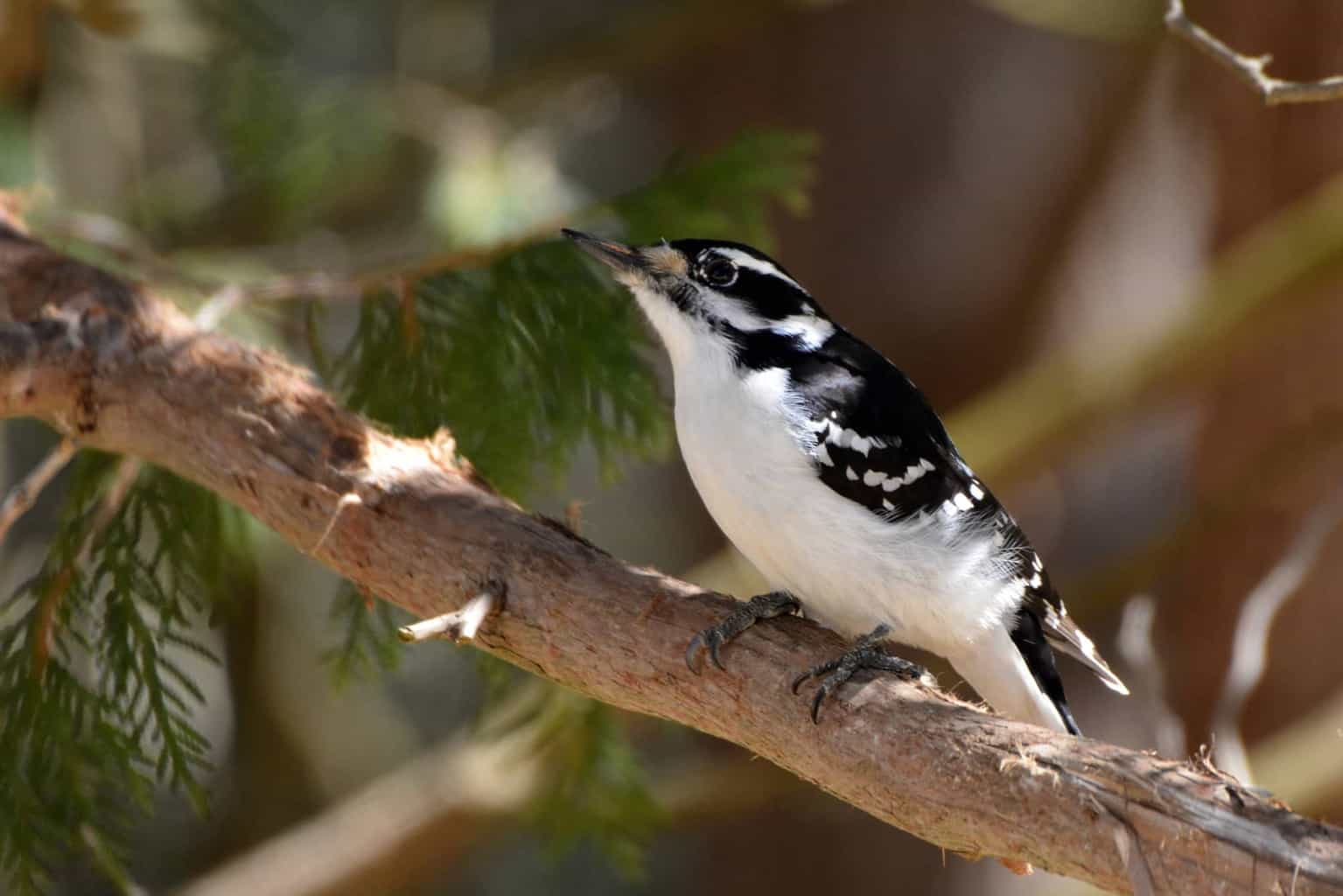
- Scientific Name: Dryobates villosus
- Length: 7.1 to 10.2 in
- Weight: 1.4 to 3.4 oz
- Wingspan: 13.0 to 17.0 in
Hairy woodpeckers look incredibly similar to the Downy woodpecker, as they also have the same red patch on the top of their head that makes them easily identifiable.
The two birds share a similar appetite for insects, fruits, seeds, and nuts, in addition to their appearance.
However, you’ll be able to tell them apart due to the apparent size difference between the two species. As the name suggests, the bird has a noticeably stockier body with a relatively large bill compared to the size of their body.
This bird’s habitat ranges from mature forests to suburban backyards, urban parks, swamps, orchards, and cemeteries.
Red-Winged Blackbird
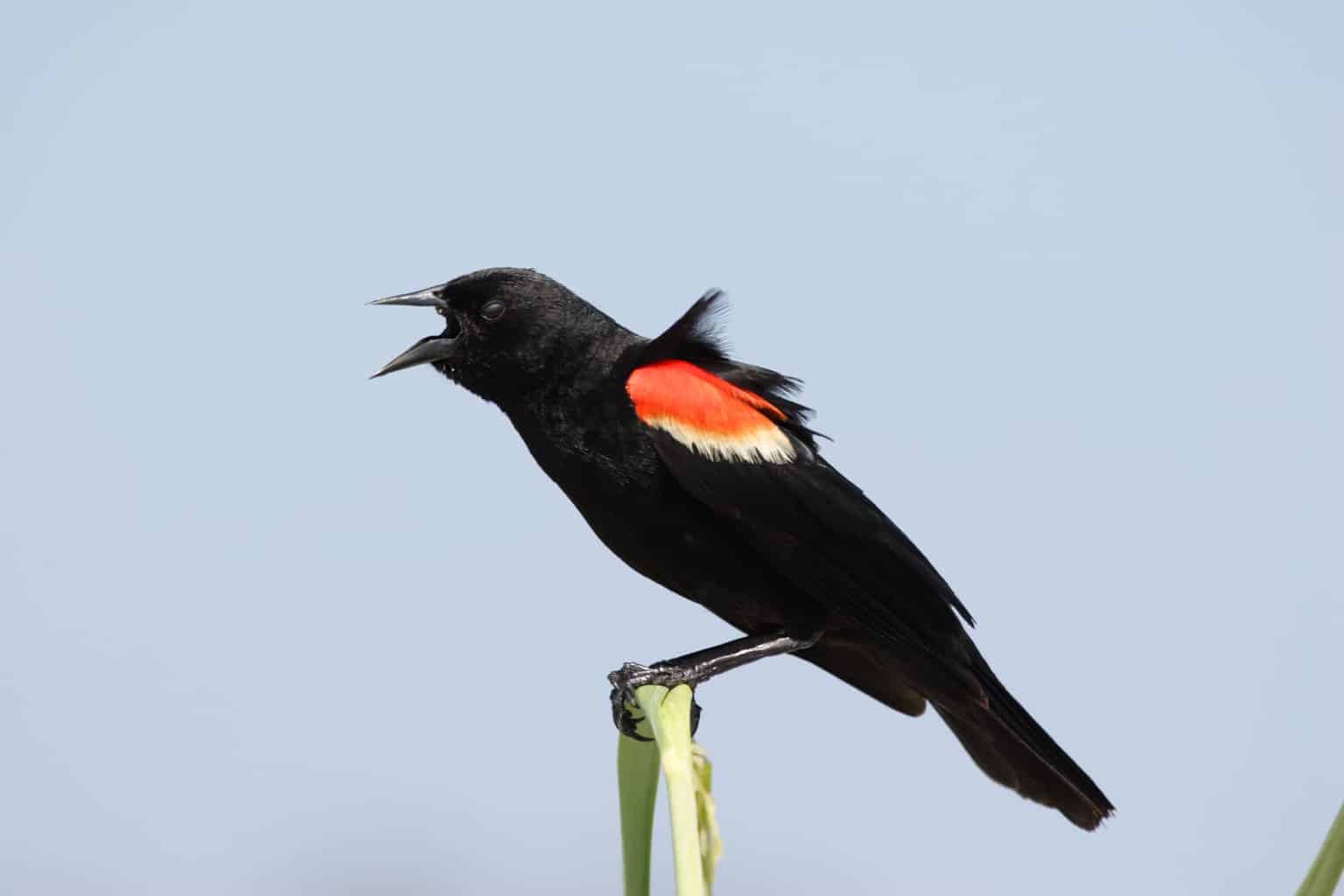
- Scientific name: Agelaius phoeniceus
- Length: 6.7 to 9.1 in
- Weight: 1.1 to 2.7 oz
- Wingspan: 12.2 to 15.8 in
The Red-tailed blackbird is among a widespread variety of blackbird species in the state of Montana. A common blackbird typically has a completely black body.
However, this bird’s unique feature is the red and yellow patch covering the top of its wings and shoulders, hence the name.
The bird likes to roam around bodies of water such as lakes, streams, and marshes where they can find insects during the breeding season. Yet, you can attract them to your backyard by adding hulled black oil sunflower seeds and corn to the bird feeder.
Red-Tailed Hawk

- Scientific Name: Buteo jamaicensis
- Length: 17.7 to 22.1 in
- Weight: 24.3 to 45.9 oz
- Wingspan: 44.9 to 52.4 in
The Red-tailed hawk is one of the most commonly reported hawks all over the state. The bird also tops the hawk charts in many neighboring states.
The bird has a mainly reddish-brown plumage with a characteristic cinnamon red tail that makes them identifiable while flying across the blue skies of Montana.
The hawk will typically soar above open countries and woodlands, as they can easily spot and hunt down squirrels, frogs, and small snakes.
Blue Birds in Montana
Common Grackle

- Scientific name: Quiscalus quiscula
- Length: 11.0 to 13.4 in
- Weight: 2.6 to 5.0 oz
- Wingspan: 14.2 to 18.1 in
Along with the Red-winged blackbird, the Common Grackle is one of the most common species of blackbirds all over the state of Montana.
Despite being classified as a blackbird, the male Common Grackle has a unique purplish blue-colored plumage covering the head, neck, and shoulders.
The bird makes loud noises and likes to fly and hang around in large flocks, so it won’t be challenging to find them.
Belted Kingfisher

- Scientific name: Megaceryle alcyon
- Length: 11.0 to 13.8 In
- Weight: 4.9 to 6.0 oz
- Wingspan: 18.9 to 22.8 inch
The Belted kingfisher is one of the unique birds you can find in the Northwestern region and Canada. The birds once made an appearance on the Canadian $5 bills!
The bird has a steely greyish-blue plumage across its head, sides, and back, with a fuzzy crest on its head.
The underparts of the bird are white. However, the females are more colorful with a characteristic chestnut brown band that covers their bellies like a belt, which is how they got their name!
Blue Jay
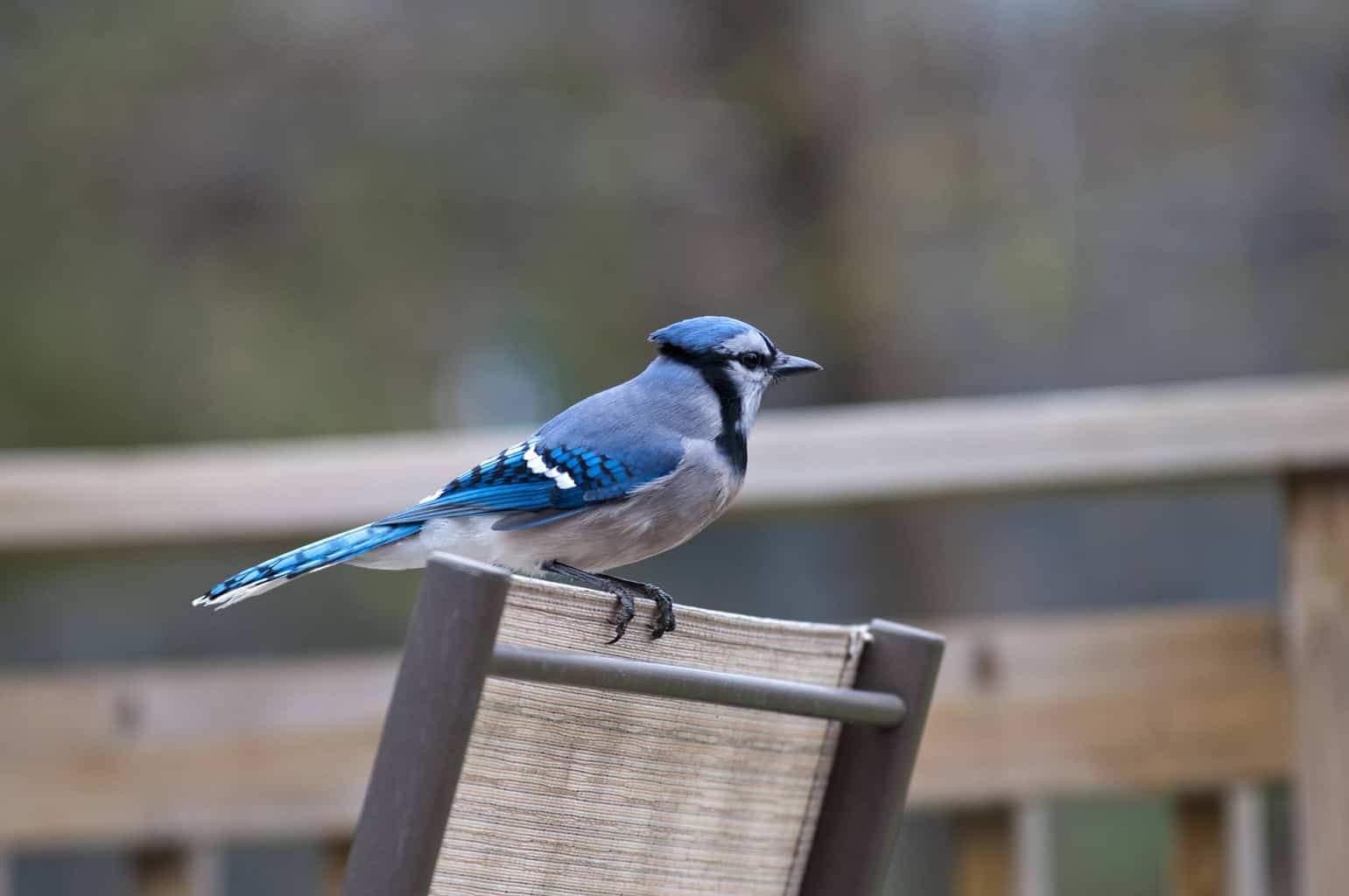
- Scientific Name: Cyanocitta cristata
- Length: 8.6 to 11.8 in
- Weight: 2.5 to 3.5 oz
- Wingspan: 13.3 to 16.9 in
There’s a massive variety of blue-colored birds in the state of Massachusetts. However, the Blue jay is easily one of the most common.
Despite having an astonishing blue and cyan color, they don’t have any blue pigments in their feathers.
Instead, they have a unique feather structure that reflects only the color blue, giving them a unique look that you’re going to love, despite being remarkably loud and noisy.
These birds enjoy a wide range of favorite foods, including seeds, insects, and even nuts. They’re also quite intelligent birds and one of the few species capable of cracking a nut open!
Barn Swallow
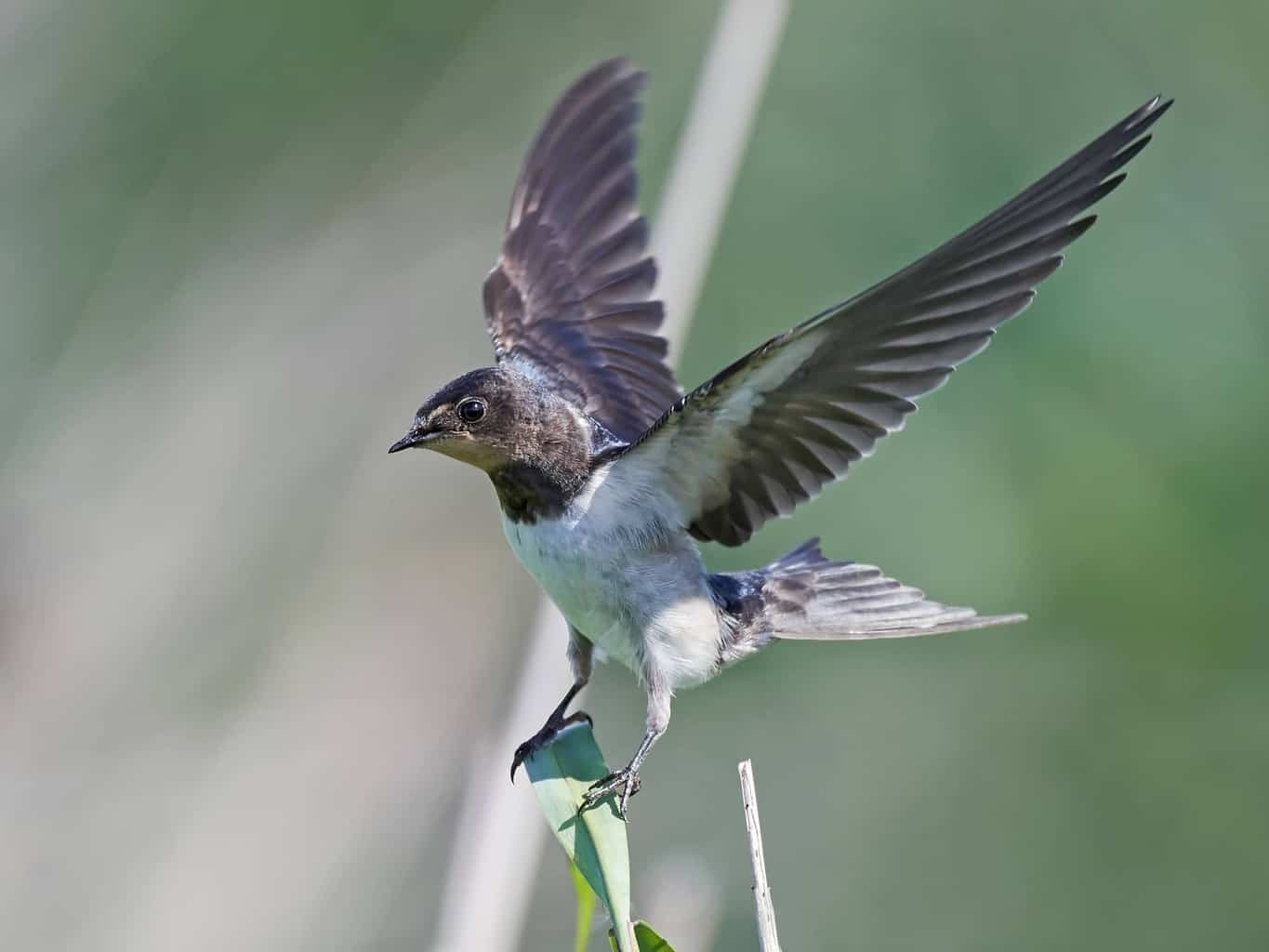
- Scientific Name: Hirundo rustica
- Length: 6.7 to 7.5 in
- Weight: 0.56 to 0.78 oz
- Wingspan: 12.6 to 13.6 in
The Barn swallow is one of the most common swallows all over America, and you can easily find them perching on telephone wires and in open fields and meadows all over the state of Montana.
The bird has a steely blue topcoat with a buff belly. The little bird has a resourceful appetite, as they can feed on a variety of insects as well as cracked eggshells.
Green Birds in Montana
Broad-Tailed Hummingbird

- Scientific name: Selasphorus platycercus
- Length: 3.1 to 3.5 in
- Weight: 0.1 to 0.2 oz
- Wingspan: 5.2 to 5.3 in
Most of the hummingbird species that you can easily spot in the United States are rare in Montana. However, the Broad-tailed hummingbird is relatively common in the state.
The majority of the hummingbird’s body is green in color, including the top of the head, the back, and the wings.
They also have an iridescent pinkish-red plumage around their throat, similar to the one found in the Ruby-throated hummingbird, which is more widespread towards the continent’s east. The bird is easily attracted to backyards using hummingbird feeders.
Violet-Green Swallow
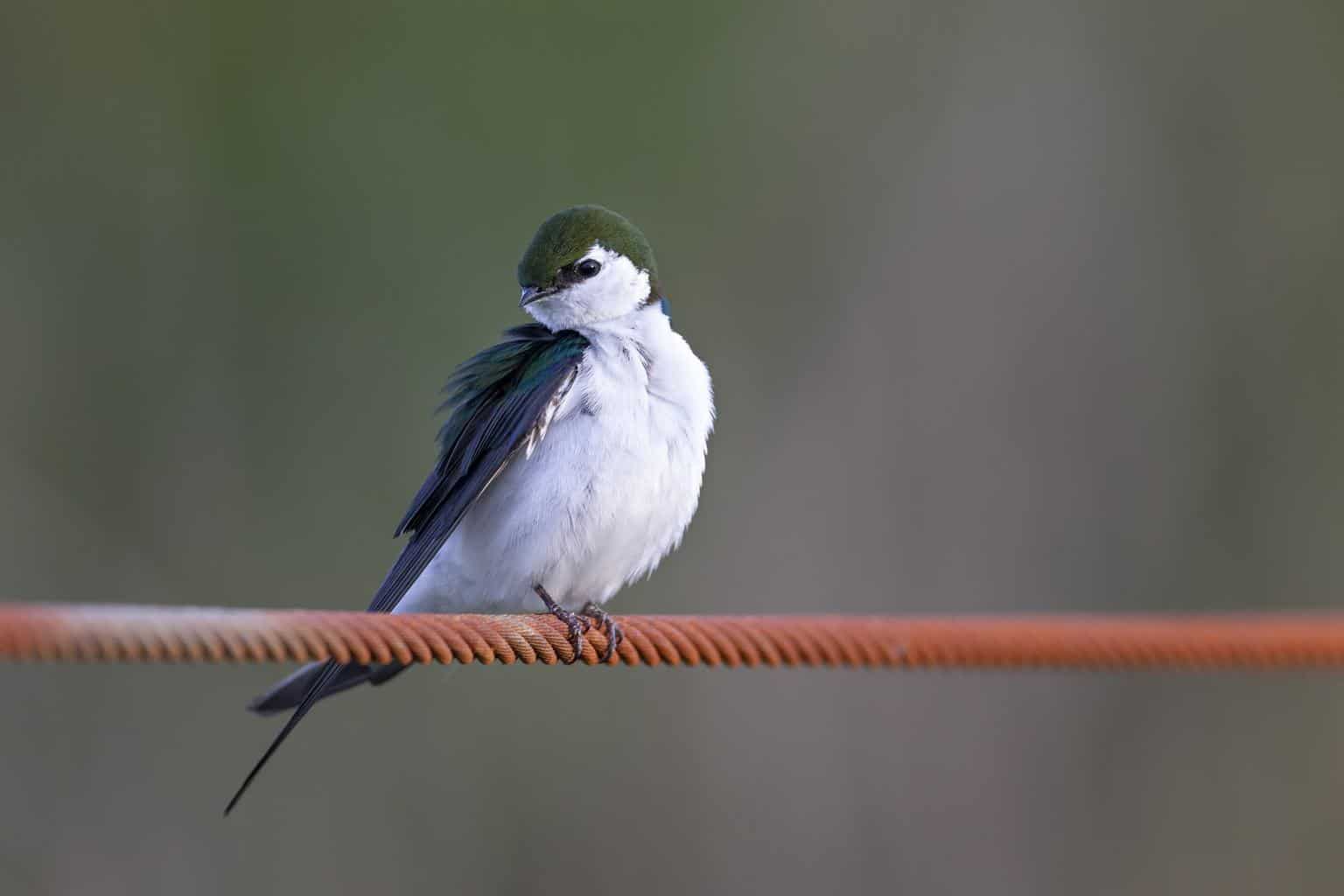
- Scientific name: Tachycineta thalassina
- Length: 4.5 to 5.0 in
- Weight: 0.4 to 0.6 oz
- Wingspan: 10.1 to 11.0 in
The Violet-green Swallow is one of the most beautiful passerines that you’ll find in the state. The birds typically exist in large numbers and have a unique acrobatic flying style that makes them easily identifiable!
The bird rocks a velvety green plumage across the head, back, and shoulders with a white face and underparts. The dark green feathers extend to their backs with faint purplish hues.
The bird primarily feeds on various insects, including wasps, bugs, ants, beetles, flies, and wild bees.
Green Heron

- Scientific Name: Butorides virescens
- Length: 16.0 to 18.0 in
- Weight: 8.3 to 8.7 oz
- Wingspan: 25.2 to 26.8 in
Green herons are medium to large-sized birds. According to the state records, the bird is an accidental species of wading bird that lives in the state during spring and fall.
They have a bronze body with a green wash all over, which shines green from a distance. Unfortunately, the Green heron’s numbers are in decline due to loss of habitat since the 1900s.
Orange Birds in Montana
American Robin

- Scientific Name: Turdus migratorius
- Length: 9.0 to 11.0 In
- Weight: 2.3 to 2.8 oz
- Wingspan: 14.7 to 16.5 In
There aren’t many birds in Montana more common than the American robin, one of the most widespread species of birds all across North America. These highly adaptable birds should be on everyone’s basic bird checklist.
The bird has a unique color pattern of bronze-orange that covers its breasts and dark-brown to black plumage across the rest of its body with the exception of a white throat.
The bird has a lovely tone when it sings and lays beautiful, vibrant sky blue color eggs.
Rufous Hummingbird

- Scientific Name: Selasphorus rufus
- Length: 2.8 to 3.5 in
- Weight: 0.1 to 0.2 oz
- Wingspan: 4.1 to 4.4 in
In addition to the Broad-billed hummingbird, the Rufous hummingbird is also quite common in Montana. This one is relatively small in size and has a slender but long bill.
Despite its small size, its rapid wing beats give it excellent flying skills allowing them to fly for thousands of miles during migration.
The bird mainly features vibrant orange feathers on its head and back. However, it has a beautiful reddish-orange iridescent throat.
Bullock’s Oriole

- Scientific name: Icterus bullockii
- Length: 6.7 to 7.5 in
- Weight: 1.0 to 1.5 oz
- Wingspan: 12.1 to 12.4 in
The Bullock’s oriole is the most common oriole in the Northwest region of the United States. However, they’re pretty similar to Baltimore oriole, which is more common as you head east.
The bird features an orange plumage all over the face, chest, and underparts of the bird. The rest of their body is black with markings of white, which you can use to tell them apart from the Baltimore variety.
Another interesting feature of the bird is the black line that runs from its head to its eyes, so it looks like it’s wearing glasses.
Scarlet Tanager
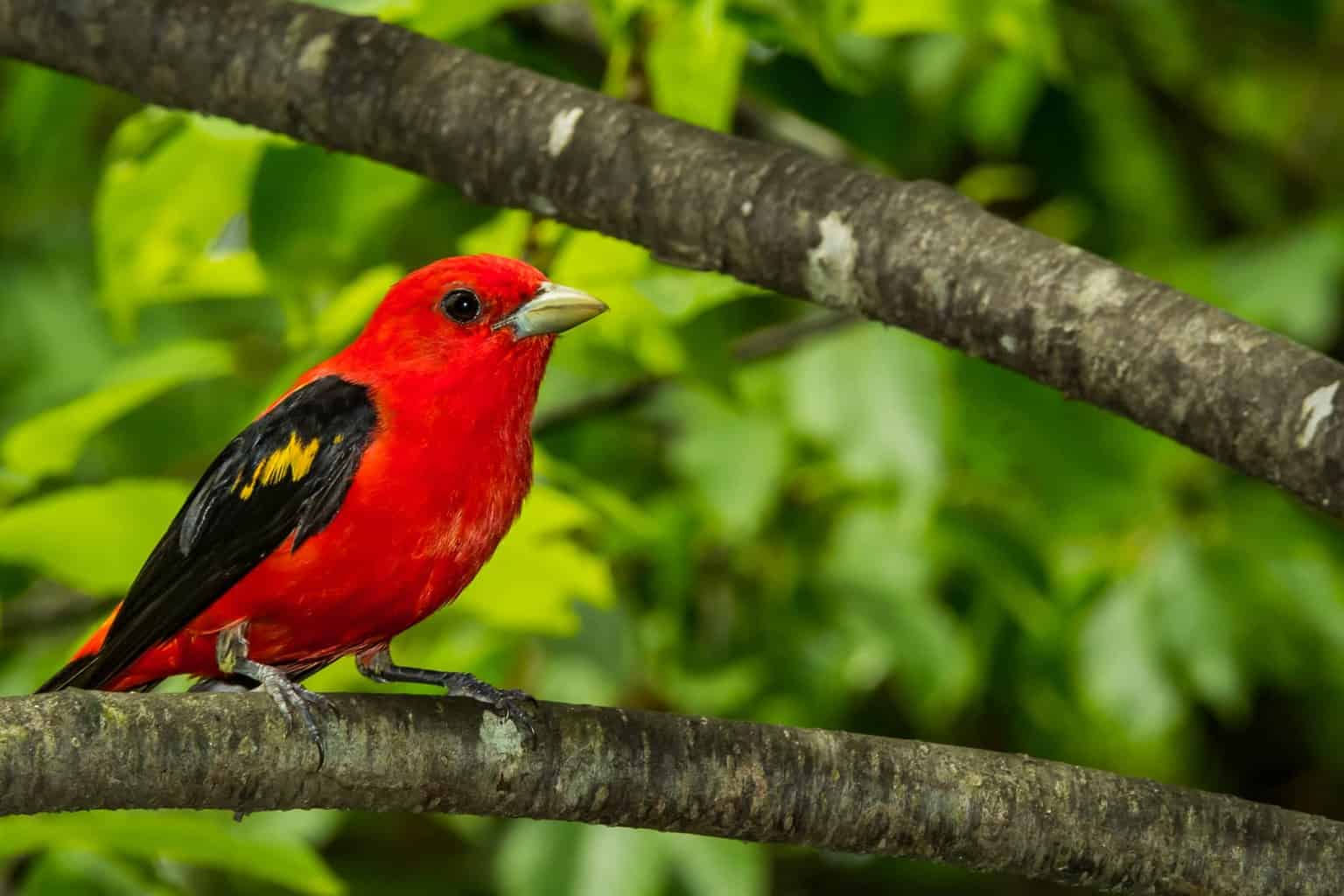
- Scientific Name: Piranga olivacea
- Length: 6.3 to 6.7 in
- Weight: 0.8 to 1.3 oz
- Wingspan: 9.8 to 11.4 in
Scarlet tanagers have a very misleading name. The bird’s classification has recently changed to cardinal rather than tanager.
Additionally, the bird isn’t a true scarlet-colored one. Instead, it has a unique flaming orange color covering the majority of its body except for the black wings and tails. It feeds on both fruits and insects.
Yellow Birds in Montana
American Goldfinch

- Scientific Name: Spinus tristis
- Length: 4.3 to 5.5 in
- Weight: 0.39 to 0.71 oz
- Wingspan: 7.5 to 8.7 in
The American goldfinch is one of the most common birds that you’ll typically find in the state of Montana. They’re common feeder birds and have a characteristic bouncy flying pattern.
Even if you’re new to bird watching, you’ll instantly be able to identify the male bird due to the golden yellow plumage all over its body except for the black crown on its head and the dark black wings.
Keep in mind that female American goldfinches will have similar patterns but with no patches on the head and much paler colors.
Yellow-Rumped Warbler

- Scientific Name: Setophaga coronata
- Length: 4.7 to 5.5 in
- Weight: 0.4 to 0.5 oz
- Wingspan: 7.5 to 9.1 in
Similar to most new word warblers, this one is known for its yellow-colored feathers. The coloration here covers the bird’s rump, face, and sides. The rest of the bird is dark black.
These colors are usually only visible in summer, as they exchange coats between seasons. The Yellow-rumped warbler likes to forage at ground level, which makes it hard to spot.
Yellow-Breasted Chat

- Scientific Name: Icteria virens
- Length: 6.7 to 7.5 In
- Weight: 0.7 to 1.19 oz
- Wingspan: 9.0 to 10.6 In
The Yellow-breasted chat is a fairly common bird during the spring in the Northwest, mainly Colorado, Idaho, Wyoming, and Montana.
The bird is known for its bright yellow body coloration all over the throat and breast, and olive-gray upperparts.
Other Birds to Watch for in Montana
Northern Flicker

- Scientific Name: Colaptes auratus
- Length: 11.0 to 14.2 in
- Weight: 3.0 to 5.9 oz
- Wingspan: 16.9 to 21.2 in
Flickers belong to the family of woodpeckers, but they mainly feed on the ground. The Northern flicker is one of the most common birds in Montana, but they may migrate to the south in winter looking for warmer weather.
The medium-sized bird has a tan plumage covered with black and brown bars and spots across its breasts, sides, and back. They have a relatively long beak and characteristic red cheeks.
The bird primarily eats insects, especially ants. Yet, they can enjoy a meal of nuts, seeds, and berries when available.
White-Breasted Nuthatch

- Scientific name: Sitta carolinensis
- Length: 5.1 to 5.5 in
- Weight: 0.6 to 1.1 oz
- Wingspan: 7.9 to 10.6 in
The White-breasted nuthatch is a lovely compact bird that is quite common all over the states. The bird has a blue-gray top with a white breast and white belly.
The bird is fairly adapted to residential areas and will often nest in wooden bird boxes. Yet, you can also find the bird in the wild, especially in dense deciduous forests.
Mourning Dove

- Scientific Name: Zenaida macroura
- Length: 11.8 to 12.2 In
- Weight: 4.3 to 6.4 oz
- Wingspan: 17.3 to 18.2 In
Mourning doves are among the most widespread species of doves all over North America, and they’re pretty common in Montana.
The bird has a characteristic pale brown to buff-colored plumage all over their bodies, except for a few spots where they have some black spots.
The bird also has a distinctive light blue ring around their eyes to help you tell them apart from other similar colored birds. The bird will typically visit bird feeders, especially if you fill them with bird seed and millet.
European Starling
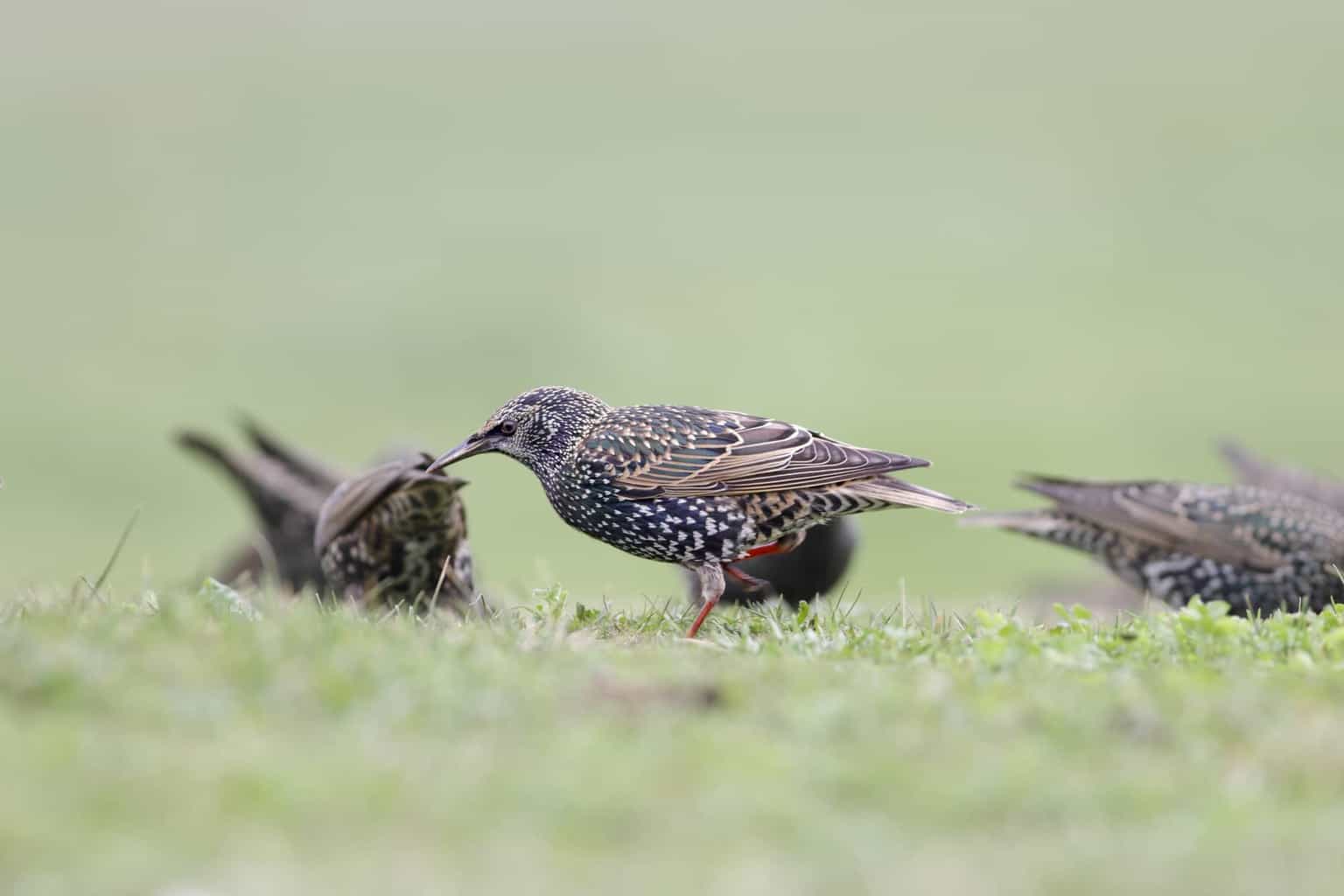
- Scientific name: Sturnus vulgaris
- Length: 7.9 to 9.1 in
- Weight: 2.1 to 3.4 oz
- Wingspan: 12.2 to 15.8 in
The European starling is an invasive species introduced to North America during the 19th century. Since then, they’ve been one of the most common species on the continent. These aggressive birds are considered a nuisance and will scare away smaller birds from feeders.
This beautiful bird has mesmerizing iridescent plumage that will shine in hues of purple and green from different angles.
These colors are more common during the summer, as the bird typically exchanges its feather winter coat with a subtle one.
Brown-Headed Cowbirds

- Scientific Name: Molothrus ater
- Length: 7.5 to 8.7 in (males) – 6.3 to 7.9 in (females)
- Weight: 1.5 to 1.8 oz (males) – 1.3 to 1.6 oz (female)
- Wingspan: 14.0 to 14.4 in (males) – 10.0 to 12.6 in (females)
Although the Brown-headed cowbird is native to North America, it’s highly unwelcome by other bird species and considered a nuisance to bird breeders.
These native birds are parasitic broods, which means that they’ll lay their eggs in other birds’ nests so that other birds raise their chicks.
The males are remarkably larger and heavier than females, resembling a chunky blackbird. However, they both share the same light brown head and dark brown color all over the rest of the body.
Rock Dove

- Scientific name: Columba livia
- Length: 11.8 to 14.2 in
- Weight: 9.3 to 13.4 oz
- Wingspan: 19.7 to 26.4 in
The Rock dove or the Rock pigeon is one of the most common tubby doves in the United States. The bird is slightly larger than other doves, including the mourning dove.
In general, the bird has a blue-grey head and coat all over its body. However, the dove’s most impressive and characteristic feature is the iridescent plumage covering the bird’s through and upper chest.
This plumage may extend from purple to green, depending on the angle at which you’re viewing the bird. The Rock pigeon also has small red eyes.
It can be found just about everywhere in the state and is attracted to feeders and leftover food on the ground.
Black-Capped Chickadee

- Scientific name: Poecile atricapillus
- Length: 4.7 to 5.9 in
- Weight: 0.3 to 0.5 oz
The Black-capped chickadee is one of the most beloved birds in the Northwest. The bird is known for its short neck and relatively large head.
One of the most characteristic features of this bold bird is the long, thin tail and the dark black color that covers the bird’s face and cap. The remainder of the bird’s body is white, including the back, the cheeks, and the wings.
Great Horned Owl

- Scientific Name: Bubo virginianus
- Length: 18.1 to 24.8 In
- Weight: 32.1 to 88.2 oz
- Wingspan: 39.8 to 57.1 In
During the night, a lot of birds will head back home to feed their young and rest. However, the Great horned owl will start to become active.
The spooky bird is known for its iconic hooting sounds and long ear tufts that look like horns in the night.
This familiar bird is typically found in the forest, where they feed on small mammals, such as raccoons and squirrels.
Wrap Up
There you have it! A brief guide that walks you through some of the most interesting and colorful birds that you can come across while you’re in the state of Montana.
As you can see, there’s no shortage of amazing birds in The Treasure State. However, this is just a list of carefully selected specimens of what you can find out there, as there are hundreds of other astonishing species that you may find while bird watching in Montana!

